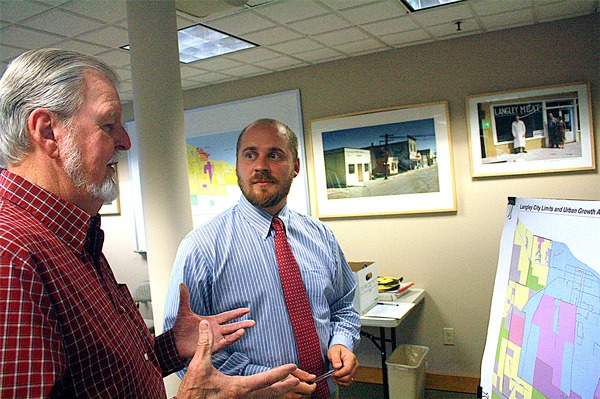By DAN RICHMAN
drichman@whidbeynewsgroup.com
Langley’s urban growth area will likely shrink to meet its needs over the next 20 years, an Island County planner told a public meeting at City Council chambers on Wednesday evening.
Washington law defines an urban growth area, or UGA, as an area in which urban growth is encouraged and outside of which growth can occur only if it is not urban in nature.
“You have far more land in your UGA than population and employment projections support,” Amanda Almgren, an associate planner, told a group of about 15 people at the meeting.
Whidbey Island has four UGAs: one each for the town of Coupeville, the non-municipal UGA of Freeland, the City of Langley and City of Oak Harbor.
State law requires counties and cities at least every eight years to review UGAs, the densities permitted within each UGA and the nature of development that has occurred.
The county commissioners hold final authority over the shape and size of UGAs, though it consults with cities on which parcels should be removed. The county only shrinks a UGA upon a city’s request.
Pieces of land can be removed from a UGA if the UGA is larger than necessary, services such as sewage cannot reasonably be provided to the parcels, and they are rural, forest or agricultural, among other criteria. It’s desirable to keep UGAs small, because cities must be able to serve the entire UGA with water and sewer service — expensive services that rely on tax revenue.
Keeping a piece of land in the UGA can have an economic upside for the landowner. If the land is in the UGA and the city annexes it, it can be built on at urban densities — roughly six to eight units per acre — versus the rural density of one unit per five acres.
Langley won’t need much land to expand into over the next 20 years, if the planners’ projections are accurate. The population is expected to grow by only 89 people, to 1,124 in 2036 from 1,035 in 2010, they said at the meeting. And only 51 jobs will be added by 2036, bringing the total to 643, from 592 in 2010.
Almgren in a visual presentation offered three options for reducing Langley’s UGA. One would conform the UGA’s boundaries to the city limits. That would accommodate the population growth but require no additional infrastructure investments.
A second option would be to eliminate some, but not all, of the existing UGA. A third would be to keep the existing UGA.
Either of the second two options would require creating a land-use plan for the area and serving the area with water and sewer service within 20 years.
Other options are also possible.
“I favor retaining as much rural land in the UGA as possible — with walking trails,” Guy Burneko, a Langley resident who walks 14 miles per week, said at the meeting.
The county will decide on Langley’s UGA’s size, and on which parcels, if any, will be removed, by “sometime in the fall,” said Brad Johnson, another county planner.
Wednesday’s meeting was part of Langley’s effort to update its Comprehensive Plan, often referred to as the Comp Plan.
The state’s Growth Management Act currently requires counties and some cities to update their Comp Plans every eight years, ensuring that regulations both keep pace with ever-changing state requirements and reflect local priorities.
The plan, intended to cover the 20 years after its issuance, allows for urban growth while protecting the environment.
It is meant to reflect changes and anticipated changes, in land use, housing, population growth, water, sewage, parks, schools, parks and recreation, transportation and shorelines.
The City of Langley plans to hold a series of monthly public meetings on the Comp Plan. The next is scheduled for Sept. 2. The city’s Planning Advisory Board, which already cast a non-binding vote to reduce the UGA to city limits, meets the first and third Wednesdays of every month at 3 p.m. at City Council chambers.



